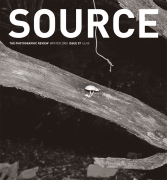Advertising
Louis Vuitton
by Judith Williamson
Issue 57 Winter 2008
View Contents ▸
There is something at once familiar and jarring about the celebrity photos of the Louis Vuitton luggage campaign. Made by Annie Leibovitz, these images are different from one another in tone and composition, and yet remarkably similar in their use of the well-worn tropes of celebrity portraiture. Each photo makes use of an already existing photographic genre to suggest something supposedly particular about the character it presents. It is culturally understood that celebrity photos of the classier kind are meant to do more than just show a famous figure – they are expected to express something special or quirky about them, as if the entire photo offered an insight not merely into what they look like, but what they are like. The repertoire of image types available for this process is itself drawn from popular genres, in particular film and advertising; which means that ads using celebrity photos represent a full turn of the circle – since celebrity photos are themselves so dependent on the image-bank provided by ads.
This is perfectly illustrated by the four examples shown here. The steamy Paris station platform, Art Film code for passion and nostalgia, envelopes Catherine Deneuve who apparently feels that ‘home is just a feeling’; the evening sun bouncing off leaves in the golden outdoors gives the tough Coppolas a mellow tinge, familiar from countless other advertising images from cereal to cider; similarly, Sean Connery lounges against a wooden pier post like a man in a Bacardi ad, surrounded by the clear water and pale sand required by this genre; while Keith Richards is presented in the stereotypical darkened hotel room – where rock stars are, of course, expected to brood moodily over their guitars at 3 a.m.
The most interesting aspect of the celebrities pictured in this campaign is that they are not aspiring B- or C-list celebs on the way up, but people who have already achieved – and are completely established in their chosen fields. Another ad in this campaign features Mikhail Gorbachev – a genuinely world-class statesman. Sean Connery and Catherine Deneuve have already been world-class film stars at the top of their careers; Keith Richards is a member of one of the world’s most successful rock bands while Francis Ford Coppola is a massively established director (and his daughter Sofia now pretty hot Hollywood property). These are people who have definitely made it: in fact, whose careers might be said to have peaked. They have succeeded, they are famous, and they have nothing to prove.
This ‘already there’ quality is essential for the Louis Vuitton campaign. For the jarring element in these photos is the luggage itself. This is a product that is all about ‘Label’: it is literally marked all over with the brand of the brand, the interlocked LV of Louis Vuitton. And yet it is a brand that is hardly unique. The undisguisedly name-displaying function of this product means that you can buy official replica versions of it online – or cheaper imitations of it down any street market. These imitations are to all intents and purposes indistinguishable from the real thing, and perform just as good a job at displaying the name. So, bizarrely, this is a luggage whose social meaning is at once aspirational and non-aspirational. Buying it and using it is a form of self-announcement that can never really be quite as classy as the consumer might like, since imitation (and official replica) versions speak in exactly the same way, and are bought in full knowledge of this. Far from the top end product donating a kind of gloss to the market version, the multitude of imitations removes an aura of class from the main product itself.
All this shows why the use of non-aspiring celebrities is so crucial to the campaign. These characters’ indisputable success, their ‘been there already’ quality as stars, is intended to give the luggage an ‘already there’ aura, counteracting its ‘wanna-be’ connotations and making it seem the choice of true success. However, the luggage still jars! Here is a fascinating example of a failure in one of advertising’s key functions – the transfer of meanings to a product. The secure stardom signified by the chosen models cannot be transferred to the product advertised, though this is clearly intended. The celebrities who have already made it to the top simply do not look convincing with their Louis Vuitton luggage. So strongly does it speak of aspiration, and imitation, that it actually looks out of place and gives a slightly camp flavour to the images. It is hard to imagine any of these celebrities actually using the luggage pictured, precisely because it is luggage designed to ‘say something’ about its user, and these are people who are so famous that they do not need to express anything about their status through monogrammed bags. Here is the tautology at the heart of the campaign, and the reason it never quite seems to work. We are supposed to believe that some of the most successful people in their fields, whose names are known all over the world, choose to use a product which is itself branded with a name intended to give status to the user, not to take its status from them.
It is amusing to imagine a Leibovitz portrait of the Queen, in her gowns at the palace, holding a Louis Vuitton handbag. In the light of these images, that doesn’t seem so very farfetched.
Other articles by Judith Williamson:
Other articles mentioning Annie Leibovitz:
Other articles on photography from the 'Advertising' category »





